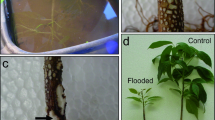Summary
The tolerance of Opuntia bigelovii Engelm. (Cactaceae) to high temperature was investigated by subjecting stems to temperatures ranging from 25°C to 65°C for a 1-h period, after which various properties of chlorenchyma cells were examined. The temperatures at which activities depending on membrane integrity decreased by 50% were 60°C for electrolyte leakage, 52°C for staining by neutral red, and 51°C for plasmolysis for plants maintained at day/night air temperatures of 30°C/20°C. Nocturnal acid accumulation, which depends on stomatal opening and enzymatic reactions as well as membrane properties, was half-inactivated at a lower temperature, 46°C. Visual observation indicated that 50% of the stems subjected to a heat treatment of 52°C became necrotic in 2 weeks.
Heat acclimation, which is apparently necessary for survival of O. bigelovii in the field, was investigated by raising the day/night air temperatures from 12°C/2°C to 60°C/50°C in 10°C steps every 2 weeks. The heat tolerance of the cellular properties increased with increasing air temperature; for a 10°C temperature increase, the half-inactivation temperature increased 2.9°C for electrolyte leakage, 3.0°C for staining, 3.8° C for stem survival, and fully 6.1°C for nocturnal acid accumulation. The relative order of these four properties with respect to heat tolerance did not change during the hardening, nocturnal acid accumulation remaining the most heat sensitive. The upper temperature for 50% survival was 59° for O. bigelovii when acclimated to day/night air temperatures of 50°C/40°C.
Similar content being viewed by others
References
Alexandrov VYa (1964) Cytophysiological and cytoecological investigations of heat resistance of plant cells toward the action of high and low temperature. Quart Rev Biol 39:35–77
Barabaltchuk KA, Tcherniavskaya VN (1974) Effect of high temperature on stomatal movement of the Tradescantia fluminensis Vell. leaves. Tsitologiia 16:1481–1487
Benson L (1974) The cacti of Arizona, 3d ed. University of Arizona Press, Tucson
Berry JA, Fork DC, Garrison S (1975) Mechanistic studies of thermal damage to leaves. Carnegie Inst Wash YB 74:751–759
Brandon PC (1967) Temperature features of enzymes affecting crassulacean acid metabolism. Plant Physiol. 42:977–984
Cockburn W, Ting IP, Sternberg LO (1979) Relationships between stomatal behavior and internal carbon dioxide concentration in Crassulacean acid metabolism plants. Plant Physiol 63:1029–1032
Feldman NL, Lutova MI, Shcherbakova AM (1975) Resistance of some proteins of Pisum sativum L. leaves after heat hardening to elevated temperature, proteolysis and shift in pH. J Therm Biol 1:47–51
Gahan PB, Kalina M (1968) The use of tetrazolium salts in the histochemical demonstration of succinic dehydrogenase activity in plant tissue. Histochemie 14:81–88
Gates DM, Alderfer R, Taylor E (1968) Leaf temperatures of desert plants. Science 159:994–995
Gibbs JG, Patten DT (1970) Plant temperatures and heat flux in a Sonoran Desert ecosystem. Oecologia (Berl) 5:165–184
Gulmon SL, Bloom AJ (1979) C3-photosynthesis and high temperature acclimation of CAM in Opuntia basilaris Engelm. and Bigel. Oecologia (Berl) 38:217–222
Hall AE, Schulze E-D (1980) Stomatal response to environment and possible interrelation between stomatal effect on transpiration and on CO2 assimilation. Plant Cell Environ 3:467–475
Hartsock TL, Nobel PS (1976) Watering converts a CAM plant to daytime CO2 uptake. Nature 262:574–576
Hoagland DR, Arnon DI (1950) The water-culture method for growing plants without soil. Calif Agric Exp Sta Circ 347:1–32
Huber B (1932) Einige Grundfragen des Wärmehaushalts der Pflanzen. I. Die Ursache der hohen Sukkulenten-Temperaturen. Ber Dtsch Bot Ges 50:68–76
Kaplan A, Gale J, Poljakoff-Mayber A (1976) Resolution of net dark fixation of carbon dioxide into its respiration and gross fixation components in Bryophyllum daigremontianum. J Exp Bot 27:220–230
Kluge M, Ting IP (1978) Crassulacean acid metabolism: Analysis of an ecological adaptation. Ecological Studies 30. Springer, Berlin-Heidelberg-New York
Koenigs JW (1966) Intracellular localization of individual dehydrogenases in frozen plant tissue by means of specific substrates and coenzymes. Stain Technol 41:1–6
Konis E (1950) On the temperature of Opuntia joints. Palest J Bot Jerusalem Ser 5:46–55
Lange OL, Koch W, Schulze E-D (1969) CO2-Gaswechsel und Wasserhaushalt von Pflanzen in der Negev-Wüste am Ende der Trockenzeit. Ber Dtsch Bot Ges 82:39–61
Larcher W (1980) Physiological plant ecology. 2d ed. Springer, Berlin-Heidelberg-New York
Levitt J (1980) Responses of plants to environmental stresses. 2d ed, Vol. 1. Chilling, freezing, and high temperature stresses. Academic Press, New York
Lewis DA, Nobel PS (1977) Thermal energy exchange model and water loss of a barrel cactus, Ferocactus acanthodes. Plant Physiol 60:609–616
MacDougal DT, Working EB (1921) A new high temperature record for growth. Carnegie Inst Wash YB 20:47–48
Mooney HA, Björkman O, Collatz GJ (1978) Photosynthetic acclimation to temperature in the desert shrub, Larrea divaricata. I. Carbon dioxide exchange characteristics of intact leaves. Plant Physiol 61:406–410
Nisbet RA, Patten DT (1974) Seasonal temperature acclimation of a prickly-pear cactus in south-central Arizona. Oecologia (Berl) 15:345–352
Nobel PS, Hartsock TL (1979) Environmental influences on open stomates of a Crassulacean acid metabolism plant, Agave deserti. Plant Physiol 63:63–66
Nobel PS, Hartsock TL (1982) Shifts in the optimal temperature for nocturnal CO2 uptake caused by changes in growth temperature for cacti and agaves. Physiol Plant 53 (in press)
Onwueme IC (1979) Rapid, plant-conserving estimation of heat tolerance in plants. J Agric Sci Camb 92:527–536
Sapper I (1935) Versuche zur Hitzeresistenz der Pflanzen. Planta 23:518–556
Smith WK (1978) Temperatures of desert plants: Another perspective on the adaptability of leaf size. Science 201:614–616
Stadelmann EJ, Kinzel H (1972) Vital staining of plant cells. In: DM Prescott (ed) Methods in cell physiology, Vol 5. Academic Press, New York, p 357–359
Tobiessen P (1976) Thermal acclimation of dark respiration in coastal and desert populations of Isomeris arborea. Amer Midl Nat 96:462–467
Author information
Authors and Affiliations
Rights and permissions
About this article
Cite this article
Didden-Zopfy, B., Nobel, P.S. High temperature tolerance and heat acclimation of Opuntia bigelovii . Oecologia 52, 176–180 (1982). https://doi.org/10.1007/BF00363833
Received:
Issue Date:
DOI: https://doi.org/10.1007/BF00363833



